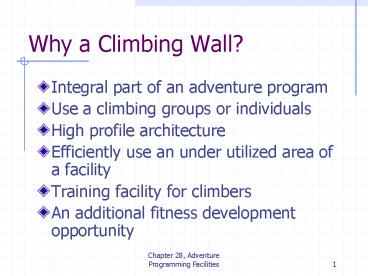Why a Climbing Wall - PowerPoint PPT Presentation
1 / 15
Title: Why a Climbing Wall
1
Why a Climbing Wall?
- Integral part of an adventure program
- Use a climbing groups or individuals
- High profile architecture
- Efficiently use an under utilized area of a
facility - Training facility for climbers
- An additional fitness development opportunity
2
Planning Questions
- Who will be the users?
- Will the wall be a stand-alone entity?
- Will the wall be used in conjunction with other
facilities? - How will the project be funded?
- Is this a new or retrofit of an existing
facility? - How much space is available?
3
Planning Questions
- How important are aesthetics?
- What type of flooring will be best for the
facility? - Do the design features promote safety, minimize
maintenance problems, and meet program needs
4
Design factors
- Wall surface real rock look, seamless cement,
panels, wood - Wall height bouldering wall 12 Commercial
height 25 to 35 competition wall 35
training wall 40 - Portable walls
- Climbing treadmills
- Wall features number, type, and location of
handholds, cracks, aretes (corner), depressions,
overhangs, caves, ledges, etc.
5
Design Factors
- Wall structure wall sub-structure must be
designed to hold weight of climbers, movement of
climbers, and impact of climbers - Security
- Storage
- Flooring movable landing mats, thickly padded
carpeting, 6 of rubber pieces or gravel
flooring extends 6 out from furthest protrusion
of the wall
6
Climbing wall types
- Homemade
- Prefabricated panel system
- Portable walls
- Climbing towers
7
Climbing Equipment
- Ropes
- Harnesses
- Helmets
- Belay system
- Locking D carabiners
- Climbing shoes
8
Safety Standards for Walls
- Supervisors are qualified instructors
- Emergency equipment available
- CPR and First Aid training for personnel
- Periodic in-service training
- Policies and emergency procedures must be posted
- Climbers must show proficiency in belay
techniques, rope handling skills, climbing
signals - Facilities regularly inspected
- Negative air pressure maintained in indoor
facility - Wall surface moderately abrasive
9
Challenge Ropes Courseslearning objectives
- Commitment
- Communication
- Fun, exhilaration, challenge
- Risk taking
- Fear management
- Team work
- Leadership
- Ability to follow
- Problem solving
- Safety education
- Trying to ones best
- The joy of effort
- Exceeding ones perceived limits
- Trust
- Cooperation
- Compassion
- Physical fitness
- Coordination
10
General Elements of Low Ropes Course
- Rope swing on knotted rope
- Spiders web
- Hanging tire
- Traversing and balancing the swinging log
- Tension traverse on low cable wire with overhead
rope
- Traverse the diverging cable wires
- Balance beam traverse
- Low wall
- Higher log beam
- Swinging tires traverse
- Catwalk or twin cable wire feet only traverse
11
High Challenge Ropes Course
- Vertical rope ladders, cargo nets, or log rungs
- Centipede poles with staples, firecracker ladders
- Inclined log, fidget ladder, or beam
- High and low cable bridge traverse
- Zip wire on a pulley
- Trapeze dive
- Pamper pole or high pedestal
- Trapeze or knotted rope swing
- Twin wire cable or rope traverse
- Cable traverse with hanging rings or vertical
ropes for hands
12
Ropes Course Maintenance
- Use pressure treated lumber
- Weatherproof wood parts
- Use only healthy trees with a solid root system
as support trees - Use wood chips or bark mulch around the base of
trees
- Immediately replace dead or insect infected trees
- Trim and cleared broken or overgrowing limbs
- Remove splinters and rough edges on all wood
parts - Replace and repair all rotten or cracked wood
13
Rope course maintenance
- Reset protruding mails
- Check for rotting of the poles in the ground
- Use only galvanized metal items (I.e., bolts,
cables, cable locks, rapid links) - Tighten nuts and bolts, turnbuckles, and clamps
- Temporarily cover all frayed cable ends
- Cover all frayed areas with permanent sleeves
- Inspect cables for smoothness
- Cables should be 3/8 wire rope that is 7 x 19 (7
stands with 19 wires per strand)
14
Challenge Ropes Course Equipment
- Use Union International Association of Alpinists
certified climbing ropes and screwgate locking
carabiners - Install only stainless steel or galvanized
hardware - Have participants wear an adjustable harness
- Maintain positive security while on the ropes
course using lobster claws - Minimize rope wear and damage by using a shear
reduction devise - Have a first aid available
- Store equipment in cool dry place
15
Challenge Ropes Course Equipment
- Lightning protection on high ropes courses
- Require helmets be worn on high or dangerous
elements - Use a gravity break on a zip line element







![[PDF] Finger Rock Climbing: Climb on! (RP Minis) Full PowerPoint PPT Presentation](https://s3.amazonaws.com/images.powershow.com/10090783.th0.jpg?_=20240802086)























